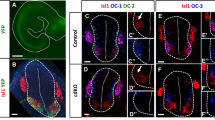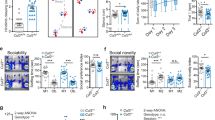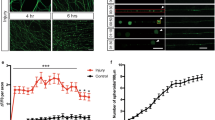Abstract
In addition to their role as chemorepellent netrin-1 receptors, UNC5 proteins may mediate cell death because they induce apoptosis in cultured cells. To test this in vivo, we generated Unc5a (formerly Unc5h1) knockout mice and found that this deletion decreased apoptosis and increased the number of neurons in the spinal cord. In contrast, loss of netrin-1 (Ntn1) did not affect the amount of apoptosis, suggesting that NTN1 is not required for neuronal apoptosis in vivo.
This is a preview of subscription content, access via your institution
Access options
Subscribe to this journal
Receive 12 print issues and online access
$209.00 per year
only $17.42 per issue
Buy this article
- Purchase on Springer Link
- Instant access to full article PDF
Prices may be subject to local taxes which are calculated during checkout



Similar content being viewed by others
References
Williams, M.E., Strickland, P., Watanabe, K. & Hinck, L. J. Biol. Chem. 278, 17483–17490 (2003).
Salehi, A.H., Xanthoudakis, S. & Barker, P.A. J. Biol. Chem. 277, 48043–48050 (2002).
Jordan, B.W. et al. J. Biol. Chem. 276, 39985–39989 (2001).
Llambi, F., Causeret, F., Bloch-Gallego, E. & Mehlen, P. EMBO J. 20, 2715–2722 (2001).
Williams, M.E., Wu, S.C., McKenna, W.L. & Hinck, L. J. Neurosci. 23, 11279–11288 (2003).
Leonardo, E.D. et al. Nature 386, 833–838 (1997).
Tsuchida, T. et al. Cell 79, 957–970 (1994).
Oppenheim, R.W. Annu. Rev. Neurosci. 14, 453–501 (1991).
Dillon, A.K. et al. J. Neurosci. 25, 10119–10130 (2005).
Wang, H., Copeland, N.G., Gilbert, D.J., Jenkins, N.A. & Tessier-Lavigne, M. J. Neurosci. 19, 4938–4947 (1999).
Kennedy, T.E., Serafini, T., de la Torre, J.R. & Tessier-Lavigne, M. Cell 78, 425–435 (1994).
Mehlen, P. et al. Nature 395, 801–804 (1998).
Tanikawa, C., Matsuda, K., Fukuda, S., Nakamura, Y. & Arakawa, H. Nat. Cell Biol. 5, 216–223 (2003).
Depaepe, V. et al. Nature 435, 1244–1250 (2005).
Acknowledgements
Antibodies to spinal accessory neurons (802C11) were a gift from S.C. Fujita (Mitsubishi Kagaku Institute of Life Sciences, Tokyo, Japan). Supported by grants from the US National Institutes of Health (NS39572- to L.H., MH12813 to M.W.), the Damon-Runyon Cancer Research Fund (X.L.) and the Howard Hughes Medical Institute (M.T.-L.).
Author information
Authors and Affiliations
Corresponding author
Ethics declarations
Competing interests
The authors declare no competing financial interests.
Supplementary information
Rights and permissions
About this article
Cite this article
Williams, M., Lu, X., McKenna, W. et al. UNC5A promotes neuronal apoptosis during spinal cord development independent of netrin-1. Nat Neurosci 9, 996–998 (2006). https://doi.org/10.1038/nn1736
Received:
Accepted:
Published:
Issue Date:
DOI: https://doi.org/10.1038/nn1736
This article is cited by
-
FANCC localizes with UNC5A at neurite outgrowth and promotes neuritogenesis
BMC Research Notes (2018)
-
Draxin from neocortical neurons controls the guidance of thalamocortical projections into the neocortex
Nature Communications (2015)
-
DNA damage-inducible gene, UNC5A, functions as a tumor-suppressor in bladder cancer
Tumor Biology (2014)
-
Intrinsic response of thoracic propriospinal neurons to axotomy
BMC Neuroscience (2010)
-
NRAGE, a p75NTR adaptor protein, is required for developmental apoptosis in vivo
Cell Death & Differentiation (2008)



